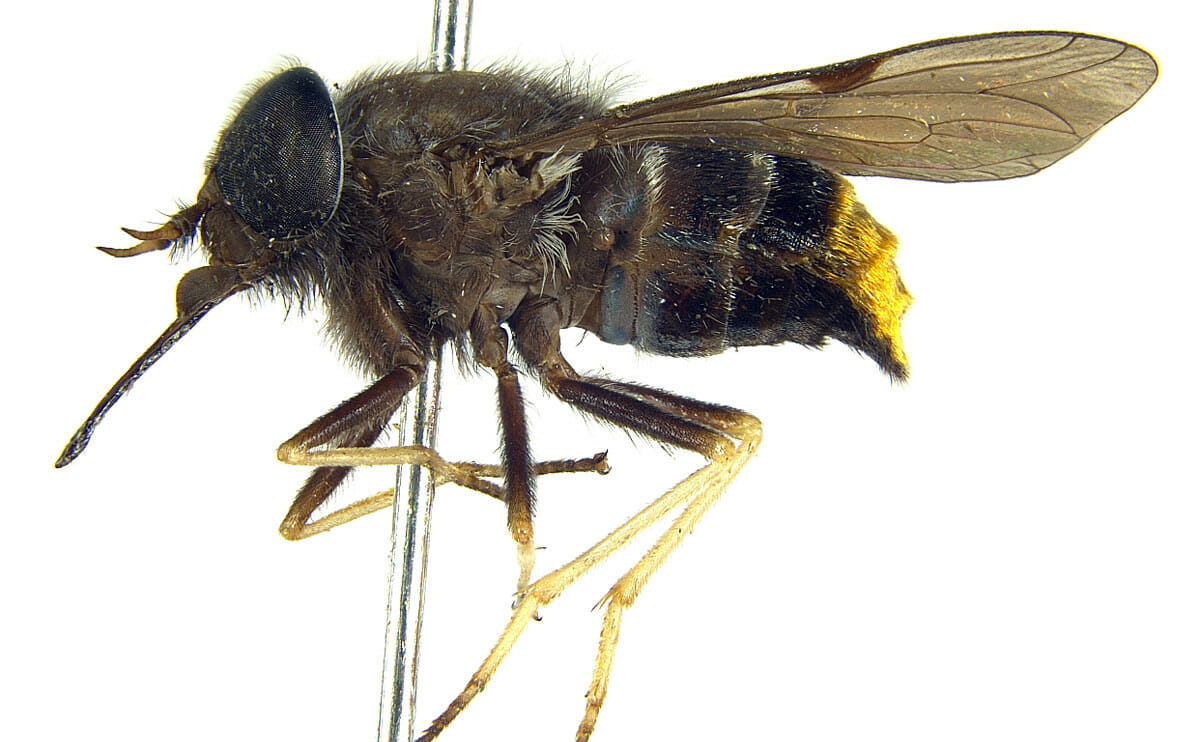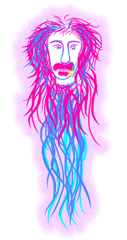Rock Stars of the Bug World
When rock stars meet bugs, the results are bugs named after the stars.
Rock Stars of the Bug World
When rock stars meet bugs, the results are bugs named after the stars.

For scientists, the name for a newly discovered plant, animal or insect is often determined by appearance, function or ecological importance – standard naming fare. However, some edgy researchers throw caution to the wind, taking a cheekier approach by naming their unearthed species after historical figures, notable personalities and – with increasing frequency – rock stars.
The International Commission on Zoological Nomenclature is a global governing body that assists with the naming of animals, and offers guidelines for those looking to label their discoveries in a way that’s slightly outside of the box.
The scientific naming formula is a complex web that’s almost enough to make a person dust off their high school history textbook. A scientific name (taxon) that specifically honors a person or persons is called a patronym; a name in honor of an entity is called an eponymous taxon. There are dozens of “dos” and “don’ts” for scientific naming, from how to properly pluralize and gender Latin words to firm restrictions on repeating names within a genus.
The most important rule, though, seems more like a humblebrag stopgap than anything else: don’t make any critter your namesake. (Sleep easy, there will be no Paleacrita Sarahbairda inchworm sliding around anytime soon.) In most cases, the animal’s genus is already defined, leaving its species name open for interpretation.
For years, there has been noticeable favoritism in the selection of classic rock stars as animal name inspiration.
For years, there has been noticeable favoritism in the selection of classic rock stars as animal name inspiration, leaving the likes of painters and religious leaders in the dust. (There is a lone extinct rodent named after Paul Cezanne.) The most likely rock star namesakes? Popular Baby Boomer artists from the freewheeling 1970s. Blame it on age or the soft rock tastes of zoologists and biologists, but spiders and rats are far more likely to be named after Pink Floyd than early-2000s mainstay Pink. The Beatles – individual and as a unit – have been the muses for a number of creatures, including the Bumba lennoni (John Lennon) spider, Avalanchurus starri (Ringo Starr) triobyte and the wriggly Greeffiella beatlei nematode. Freddie Mercury has a namesake East African crustacean, due to his roots as the most popular singer in his native Tanzania (formerly Zanzibar). Mick Jagger even gets in the mix with his own personal snail, the Anomphalus jaggerius.
However, 2015 might be the year that the punk scene overtakes classic rock as a source of critter-naming inspiration. Late last year, scientists deemed a deep sea snail with a particularly edgy, spiky shell Alviniconcha strummeri after lead guitarist Joe Strummer from the iconic British punk band The Clash. The Indian Ocean-based snail lives in one of the harshest underwater environments imaginable: near a giant, hydrothermal vent.
“Because they look like punk rockers in the 70s and 80s and they have purple blood and live in such an extreme environment, we decided to name one new species after a punk rock icon,” Shannon Johnson, a researcher at the Monterey Bay Aquarium Research Institute, told the Santa Cruz Sentinel.
The Strummer-named snail follows in a small-but-mighty line of hardcore insects and arachnids. A genus of subterranean Mediterranean “velvet” spiders was named after Velvet Underground front man Lou Reed in 2012. 1998 saw trilobites named after the Sex Pistols as well as each member of the Ramones, from Dee Dee (Mackenziurus deedeei) to Johnny (Mackenziurus johnnyi). While we might not live to see my punk-insect dream of a Bikini Kill slug, it wouldn’t be surprising if in the next 20 years, a five-legged beetle named after One Direction crawled its way into the scientific record.
Below are four insects and sea creatures that seems to be particularly well-named after guitar-strumming, booty-shaking inspirations:
Scaptia (Plinthina) beyonceae, Australian horsefly
Inspiration: Beyonce
This horsefly – named in 2011, before Queen Bey’s reign began in earnest – was crowned with this regal title because of its golden-hued posterior. “It was the unique dense golden hairs on the fly’s abdomen that led me to name this fly in honor of the performer Beyonce, as well as giving me the chance to demonstrate the fun side of taxonomy – the naming of species,” lead researcher Bryan Lessard said. Beyonce has yet to comment on her namesake bug.

Inspiration: Jerry Garcia
Laid-back, pot-smoking legend and Grateful Dead lead singer Jerry Garcia received the ultimate honor of having a woodland roach named after him after decades of smoking a (very different kind) of roach. The insect – which was christened in 1997 after the singer’s untimely death – is rumored to be easily soothed by the sweet sounds of Jerry and Merl Saunders playing “Soul Roach” if encountered in the wild.*
*This is wild speculation.

Inspiration: James Taylor and Carole King
The acoustic-and-piano driven twosome are the favorites of Volvo-driving moms everywhere, and can almost always be found on the airwaves of a soft rock radio station. Their commitment to environmental causes led to the naming of stoneflies (which are completely intolerant of water pollution) in their honor.

Inspiration: Frank Zappa
Scientists love Frank Zappa almost more than any other musician – extinct rodents, snails, spiders, bacteria and an entire genus of fish are named after the quirky singer. No one put more effort into the naming process, though, than Italian jellyfish expert Ferdinando “Nando” Boero, who titled his tentacle-waving underwater discovery after Zappa in the hopes of meeting the musician. When told of his jellyfish counterpart, Zappa is rumored to have said, “There is nothing I would like better than having a jellyfish with my name.”
Top photo courtesy Commonwealth Scientific and Industrial Research Organisation./Illustration by Sarah Baird and Kyle Sheehan.
Follow us
This work is licensed under a Creative Commons Attribution-NoDerivatives 4.0 International License.
Want to republish a Modern Farmer story?
We are happy for Modern Farmer stories to be shared, and encourage you to republish our articles for your audience. When doing so, we ask that you follow these guidelines:
Please credit us and our writers
For the author byline, please use “Author Name, Modern Farmer.” At the top of our stories, if on the web, please include this text and link: “This story was originally published by Modern Farmer.”
Please make sure to include a link back to either our home page or the article URL.
At the bottom of the story, please include the following text:
“Modern Farmer is a nonprofit initiative dedicated to raising awareness and catalyzing action at the intersection of food, agriculture, and society. Read more at <link>Modern Farmer</link>.”
Use our widget
We’d like to be able to track our stories, so we ask that if you republish our content, you do so using our widget (located on the left hand side of the article). The HTML code has a built-in tracker that tells us the data and domain where the story was published, as well as view counts.
Check the image requirements
It’s your responsibility to confirm you're licensed to republish images in our articles. Some images, such as those from commercial providers, don't allow their images to be republished without permission or payment. Copyright terms are generally listed in the image caption and attribution. You are welcome to omit our images or substitute with your own. Charts and interactive graphics follow the same rules.
Don’t change too much. Or, ask us first.
Articles must be republished in their entirety. It’s okay to change references to time (“today” to “yesterday”) or location (“Iowa City, IA” to “here”). But please keep everything else the same.
If you feel strongly that a more material edit needs to be made, get in touch with us at [email protected]. We’re happy to discuss it with the original author, but we must have prior approval for changes before publication.
Special cases
Extracts. You may run the first few lines or paragraphs of the article and then say: “Read the full article at Modern Farmer” with a link back to the original article.
Quotes. You may quote authors provided you include a link back to the article URL.
Translations. These require writer approval. To inquire about translation of a Modern Farmer article, contact us at [email protected]
Signed consent / copyright release forms. These are not required, provided you are following these guidelines.
Print. Articles can be republished in print under these same rules, with the exception that you do not need to include the links.
Tag us
When sharing the story on social media, please tag us using the following: - Twitter (@ModFarm) - Facebook (@ModernFarmerMedia) - Instagram (@modfarm)
Use our content respectfully
Modern Farmer is a nonprofit and as such we share our content for free and in good faith in order to reach new audiences. Respectfully,
No selling ads against our stories. It’s okay to put our stories on pages with ads.
Don’t republish our material wholesale, or automatically; you need to select stories to be republished individually.
You have no rights to sell, license, syndicate, or otherwise represent yourself as the authorized owner of our material to any third parties. This means that you cannot actively publish or submit our work for syndication to third party platforms or apps like Apple News or Google News. We understand that publishers cannot fully control when certain third parties automatically summarize or crawl content from publishers’ own sites.
Keep in touch
We want to hear from you if you love Modern Farmer content, have a collaboration idea, or anything else to share. As a nonprofit outlet, we work in service of our community and are always open to comments, feedback, and ideas. Contact us at [email protected].by Sarah Baird, Modern Farmer
January 12, 2015
Modern Farmer Weekly
Solutions Hub
Innovations, ideas and inspiration. Actionable solutions for a resilient food system.
ExploreExplore other topics
Share With Us
We want to hear from Modern Farmer readers who have thoughtful commentary, actionable solutions, or helpful ideas to share.
SubmitNecessary cookies are absolutely essential for the website to function properly. This category only includes cookies that ensures basic functionalities and security features of the website. These cookies do not store any personal information.
Any cookies that may not be particularly necessary for the website to function and are used specifically to collect user personal data via analytics, ads, other embedded contents are termed as non-necessary cookies.